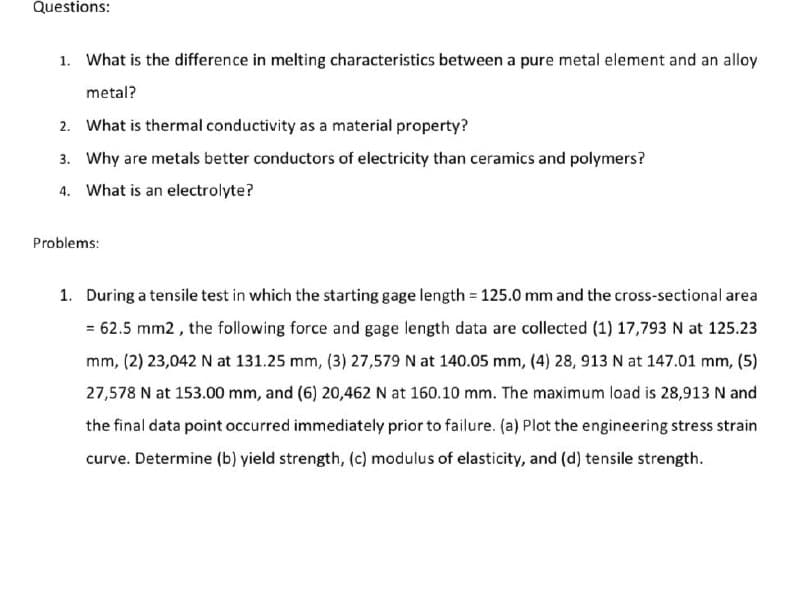1. What is the difference in melting characteristics between a pure metal element and an alloy metal? 2. What is thermal conductivity as a material property? 3. Why are metals better conductors of electricity than ceramics and polymers? 4. What is an electrolyte?
1. What is the difference in melting characteristics between a pure metal element and an alloy metal? 2. What is thermal conductivity as a material property? 3. Why are metals better conductors of electricity than ceramics and polymers? 4. What is an electrolyte?
Chemistry
10th Edition
ISBN:9781305957404
Author:Steven S. Zumdahl, Susan A. Zumdahl, Donald J. DeCoste
Publisher:Steven S. Zumdahl, Susan A. Zumdahl, Donald J. DeCoste
Chapter1: Chemical Foundations
Section: Chapter Questions
Problem 1RQ: Define and explain the differences between the following terms. a. law and theory b. theory and...
Related questions
Question

Transcribed Image Text:Questions:
1. What is the difference in melting characteristics between a pure metal element and an alloy
metal?
2. What is thermal conductivity as a material property?
3. Why are metals better conductors of electricity than ceramics and polymers?
4. What is an electrolyte?
Problems:
1. During a tensile test in which the starting gage length = 125.0 mm and the cross-sectional area
= 62.5 mm2 , the following force and gage length data are collected (1) 17,793 N at 125.23
mm, (2) 23,042 N at 131.25 mm, (3) 27,579 N at 140.05 mm, (4) 28, 913 N at 147.01 mm, (5)
27,578 N at 153.00 mm, and (6) 20,462 N at 160.10 mm. The maximum load is 28,913 N and
the final data point occurred immediately prior to failure. (a) Plot the engineering stress strain
curve. Determine (b) yield strength, (c) modulus of elasticity, and (d) tensile strength.
Expert Solution
This question has been solved!
Explore an expertly crafted, step-by-step solution for a thorough understanding of key concepts.
This is a popular solution!
Trending now
This is a popular solution!
Step by step
Solved in 2 steps with 2 images

Knowledge Booster
Learn more about
Need a deep-dive on the concept behind this application? Look no further. Learn more about this topic, chemistry and related others by exploring similar questions and additional content below.Recommended textbooks for you

Chemistry
Chemistry
ISBN:
9781305957404
Author:
Steven S. Zumdahl, Susan A. Zumdahl, Donald J. DeCoste
Publisher:
Cengage Learning

Chemistry
Chemistry
ISBN:
9781259911156
Author:
Raymond Chang Dr., Jason Overby Professor
Publisher:
McGraw-Hill Education

Principles of Instrumental Analysis
Chemistry
ISBN:
9781305577213
Author:
Douglas A. Skoog, F. James Holler, Stanley R. Crouch
Publisher:
Cengage Learning

Chemistry
Chemistry
ISBN:
9781305957404
Author:
Steven S. Zumdahl, Susan A. Zumdahl, Donald J. DeCoste
Publisher:
Cengage Learning

Chemistry
Chemistry
ISBN:
9781259911156
Author:
Raymond Chang Dr., Jason Overby Professor
Publisher:
McGraw-Hill Education

Principles of Instrumental Analysis
Chemistry
ISBN:
9781305577213
Author:
Douglas A. Skoog, F. James Holler, Stanley R. Crouch
Publisher:
Cengage Learning

Organic Chemistry
Chemistry
ISBN:
9780078021558
Author:
Janice Gorzynski Smith Dr.
Publisher:
McGraw-Hill Education

Chemistry: Principles and Reactions
Chemistry
ISBN:
9781305079373
Author:
William L. Masterton, Cecile N. Hurley
Publisher:
Cengage Learning

Elementary Principles of Chemical Processes, Bind…
Chemistry
ISBN:
9781118431221
Author:
Richard M. Felder, Ronald W. Rousseau, Lisa G. Bullard
Publisher:
WILEY